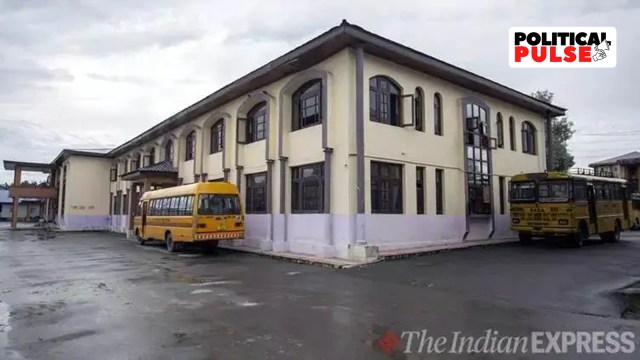J&K textbooks to soon get ‘new local heroes’: Who are they?
While Zorawar Singh was a commander in the Dogra army, said to have been key in expanding its empire, Maqbool Sherwani and Brig Rajinder Jamwal played a role in the post-Independence war with Pakistan.
 The textbooks will include the biographies of local heroes. (Express Photo by Shuaib Masoodi)
The textbooks will include the biographies of local heroes. (Express Photo by Shuaib Masoodi)Speaking at Jammu university on Tuesday, Jammu and Kashmir Lieutenant Governor Manoj Sinha said the “life struggles of local heroes” such as General Zorawar Singh, Brigadier Rajinder Singh and Maqbool Sherwani would soon be included in the curriculum of schools in the state.
Who are these leaders and what role do they play in J&K’s history?
General Zorawar Singh
Zorawar Singh, a general in the army of Dogra ruler Maharaja Gulab Singh, is known for his role in expanding the Dogra kingdom into Ladakh, Baltistan, Skardu and parts of Western Tibet in the 1830s.
Born in a Rajput family in the princely state of Kahlur (present day Bilaspur in Himachal Pradesh), his family had migrated to the Jammu region. Singh went on to serve as commander of the Bhimgarh fort in Reasi.
Gulab Singh, said to have been impressed with Zorawar Singh’s military skills, appointed him as the commanding officer of all forts situated north of Jammu. He was made Governor of Kishtwar.
According to historians, Zorawar Singh conquered the Paddar region in 1835, which later became famous for its sapphire mines, from the ruler of Chamba.
With a 5,000 member army, he is said to have ventured into the territory of modern day Ladakh through the Suru river and defeated the local Botis.
In 1836, the ruler of Ladakh, Tsepal Namgyal, revolted. However, Zorawar Singh is said to have squashed this rebellion.
Zorawar Singh is then said to have moved to Baltistan on the northwest of Ladakh and invaded it in the winter of 1839-’40, adding a large contingent of Ladakhis to his army. He also conquered the Baotis of Skardu and then built a fort on the banks of the Indus river there.
From Leh, Zorawar Singh’s troops moved towards Tibet. He is said to have defeated Tibetan troops stationed at Gartok, causing their commander to flee to Taklakot.
Zorawar Singh and his men are said to have extended his communication and supply line over 450 miles between Mansarovar and Mount Kailash by building small forts and pickets along the way.
However, all the supplies to the Dogra army got snapped with the closure of all the mountainous passes during winter.
In the meantime, Tibetans and their Chinese allies regrouped and attacked the Dogra army at To-yo on December 12, 1841. Zorawar Singh was killed by the Tibetan army.
Maqbool Sherwani
A 19-year-old National Conference member, Sherwani played a key role in stalling the Pakistan-backed tribesmen as they were making their way to Srinagar in October 1947.
On October 22, Pakistani-backed raiders from the North West Frontier Province had already entered Baramulla, which was 54 km from Srinagar. Indian forces were still days away from sending troops to Kashmir in the absence of the Instrument of Accession.
Many believe that if Srinagar had fallen to the raiders, the outcome of the 1947 war with Pakistan would have been different.
However, Sherwani is said to have ensured that the Indian forces had enough time to reach Srinagar and fight back the raiders.
There are two different versions of this incident. One says that Sherwani told the raiders that he would show them the shortest way to reach Srinagar and then led them astray. The other says that he told them that the Indian Army had already landed in Srinagar. Sherwani eventually succumbed to the raiders.
Finally when raiders reached the outskirts of Srinagar, they were intercepted by the Indian Army at Shalteng on November 7, 1947, and made to retreat.
On November 8, 1947, Indian forces reached Baramulla and retrieved the body of Sherwani.
Every year, the Indian Army commemorates him as the “Saviour of Kashmir” on its Infantry Day. It has also constructed a memorial hall in his name in Baramulla town.
Brigadier Rajinder Singh Jamwal
Jamwal briefly served as the Chief of Staff of the J&K state forces during the first Indo-Pak war.
Leading a small contingent of nearly 200 men on October 22, 1947, he was crucial in stopping the advancement of a much-larger force of Pakistan-backed raiders near Uri for several days. The last Dogra Maharaja, Hari Singh, is said to have ordered Jamwal to defend the state “till last man and the last bullet until the arrival of Indian forces”.
Jamwal sustained serious injuries, but he ordered his men to continue with the planned defensive strategy, and leave him where he was. His men continued the fight until the next day, but nearly all were killed soon after.
However the group managed to resist the tribesmen for nearly four days. The Instrument of Accession with the Indian Union was signed on October 26. Jamwal died of injuries a day later.
He was posthumously awarded Maha Vir Chakra, second highest military decoration, on December 30, 1949. He was the first Indian to receive this honour under the Jawaharlal Nehru government.
Brought up by his uncle Lt Colonel Govind Singh, Jamwal had graduated from the Prince of Wales College, now GGM Science College, in 1921.
Jamwal is also referred to as the “Saviour of Kashmir”. His native hometown of Bagoona was renamed as Rajinderpura.
A park in Bagoona and a canal in Jammu have been named after him.
- 01
- 02
- 03
- 04
- 05





























